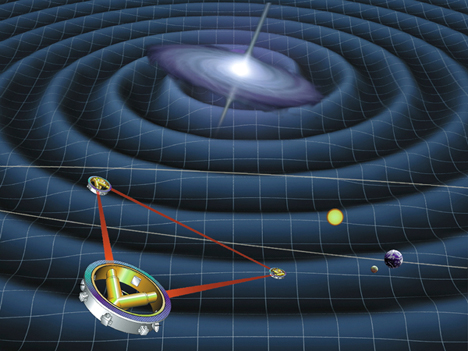
![]()
Home | Crosswords | Word Searches | Flash Cards | Verbs | Songs | Creative Writing | Work Sheets | Phonics | ABCs Potion Book | Spell Book | ESL for Adults | Ask Thomas | Lesson Plans | Scott Foresman ESL | Jobs | Web Guide
Hunting for Mystery Waves

LISA's three spacecraft will be 3 million miles apart, connected only by laser beams.
If you sat at the edge of a small pond, and dropped objects into the water, you could tell something about those objects from the ripples. One stone dropped into the water would make waves different from the waves made by two stones. By detecting gravitational waves, scientists could get clues about large objects in space.
Gravity is what keeps your clothes on the floor where you left them. We know what gravity does, but we're not sure what it is. The scientist Albert Einstein believed space curves around objects. The bigger the object, the more space would curve. Huge things, like planets, would curve space so much, other objects (like the moon), would orbit around them. Humongous objects, like two suns in orbit around each other, are like big rocks. They make ripples of gravity that spread out into space.
The Laser Interferometer Space Antenna (LISA) would be three spacecraft flying three million miles apart. Sensitive laser beams would connect them. As gravitational waves passed through LISA, the distance or positions between the ships would change. Scientists would know the strength and shape of the waves by measuring those changes. If you put three small boats in your pond, and connected them with string, you could detect ripples by watching the way the string moved.
For more information about LISA and gravitational waves, visit The Space Place at http://spaceplace.nasa.gov/lisa_fact2.htm
This article was written by Eric Elkins and provided by the Jet Propulsion Laboratory, California Institute of Technology, in Pasadena.